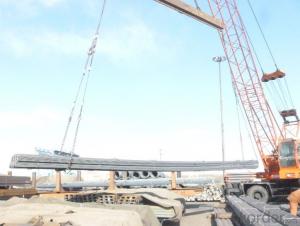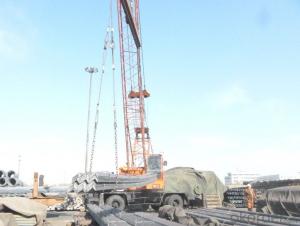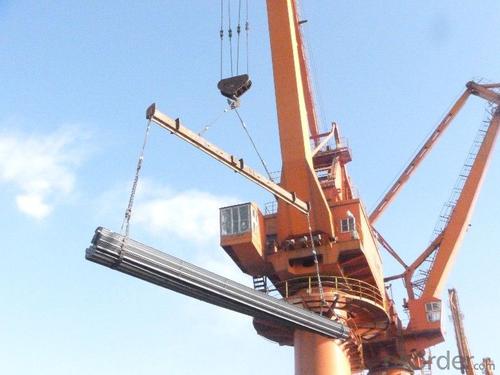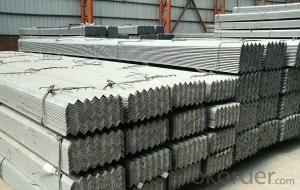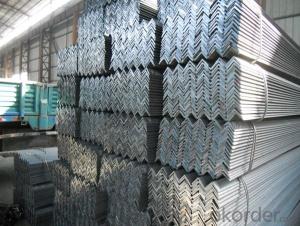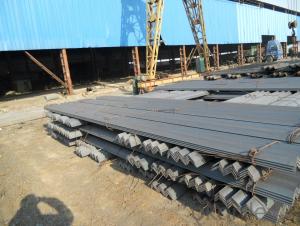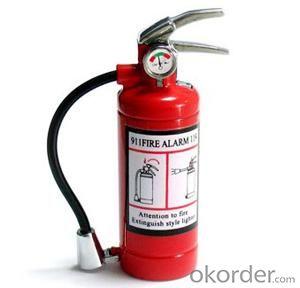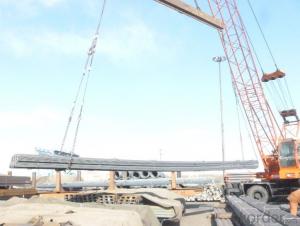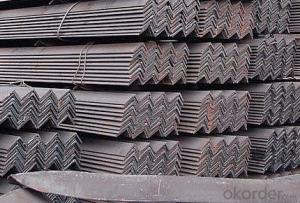alloy angle steel 5#
- Loading Port:
- China Main Port
- Payment Terms:
- TT OR LC
- Min Order Qty:
- -
- Supply Capability:
- -
OKorder Service Pledge
OKorder Financial Service
You Might Also Like
Product Description:
Specifications of JIS SS400 Angle Steel
1.Standards:GB,ASTM,BS,AISI,DIN,JIS
2.Invoicing on theoretical weight or actual weight as customer request
3.Material: JIS G3192,SS400;SS540.
4. Payment terms:
1).100% irrevocable L/C at sight.
2).30% T/T prepaid and the balance against the copy of B/L.
3).30% T/T prepaid and the balance against L/C
5.Sizes:
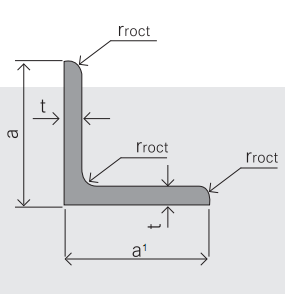
EQUAL ANGLES SIZES |
| ||
a(mm) | a1(mm) | thickness(mm) | length |
25 | 25 | 2.5---3.0 | 6M/12M |
30 | 30 | 2.5---4.0 | 6M/12M |
38 | 38 | 2.5 | 6M/12M |
38 | 38 | 3.0---5.0 | 6M/12M |
40 | 40 | 3.0---6.0 | 6M/12M |
50 | 50 | 3 | 6M/12M |
50 | 50 | 3.7---6.0 | 6M/9M/12M |
60 | 60 | 5.0---6.0 | 6M/9M/12M |
63 | 63 | 6.0---8.0 | 6M/9M/12M |
65 | 65 | 5.0---8.0 | 6M/9M/12M |
70 | 70 | 6.0---7.0 | 6M/9M/12M |
75 | 75 | 5.0---10.0 | 6M/9M/12M |
80 | 80 | 6.0---10.0 | 6M/9M/12M |
90 | 90 | 6.0---10.0 | 6M/9M/12M |
100 | 100 | 6.0---12.0 | 6M/9M/12M |
120 | 120 | 8.0-12.0 | 6M/9M/12M |
125 | 125 | 8.0---12.0 | 6M/9M/12M |
130 | 130 | 9.0-12.0 | 6M/9M/12M |
140 | 140 | 10.0-16.0 | 6M/9M/12M |
150 | 150 | 10---15 | 6M/9M/12M |
160 | 160 | 10---16 | 6M/9M/12M |
180 | 180 | 12---18 | 6M/9M/12M |
200 | 200 | 14---20 | 6M/9M/12M |
5. Material Specifications:
Grade | Yield Strength,N/mm² | Extension Strength N/mm² | |||
Thickness of Steel,mm | |||||
≦16 | >16-≦40 | >40-≦100 | >100 | ||
SS330 | ≧205 | ≧195 | ≧175 | ≧165 | 330-430 |
SS400 | ≧245 | ≧235 | ≧215 | ≧205 | 400-510 |
SS490 | ≧285 | ≧275 | ≧255 | ≧245 | 490-610 |
SS540 | ≧400 | ≧390 | - | - | ≧540 |
Usage & Applications JIS SS400 Angle Steel
Trusses;
Transmission towers;
Telecommunication towers;
Bracing for general structures;
Stiffeners in structural use.
Packaging & Delivery of JIS SS400 Angle Steel
1. Transportation: the goods are delivered by truck from mill to loading port, the maximum quantity can be loaded is around 40MTs by each truck. If the order quantity cannot reach the full truck loaded, the transportation cost per ton will be little higher than full load.
2. With bundles and load in 20 feet/40 feet container, or by bulk cargo, also we could do as customer's request.
3. Marks:
Color mark: There will be color marking on both end of the bundle for the cargo delivered by bulk vessel. That makes it easily to distinguish at the destination port.
Tag mark: There will be tag mark tied up on the bundles. The information usually including supplier logo and name, product name, made in China, shipping marks and other information request by the customer.
If loading by container the marking is not needed, but we will prepare it as customer request.
Production flow of JIS SS400 Angle Steel
Material prepare (billet) —heat up—rough rolling—precision rolling—cooling—packing—storage and transportation
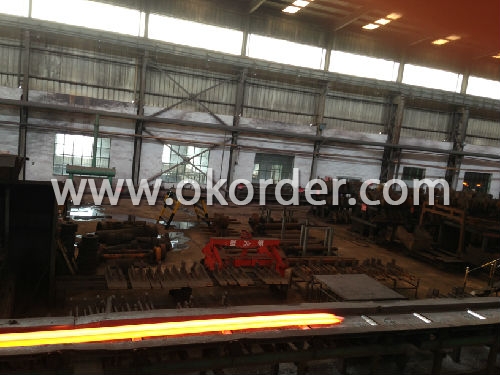
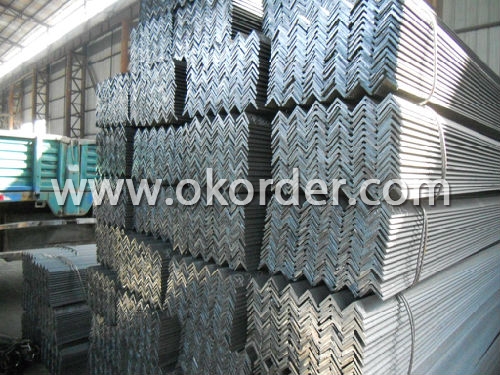
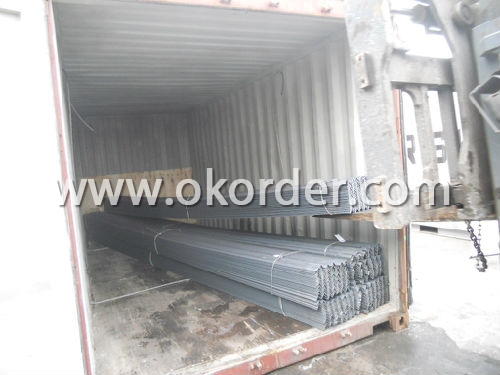
- Q: What are the different methods of surface protection for steel angles?
- Steel angles can be protected using various methods, each with its own pros and cons. 1. Painting: A common approach is to apply a layer of paint, creating a barrier between the steel and its surroundings. Paint offers both aesthetic appeal and corrosion resistance. However, it may need regular maintenance and can chip or peel over time. 2. Galvanization: This involves coating the steel angle with a layer of zinc, which acts as a protective barrier against corrosion. Galvanization can be achieved through hot-dip or electro-galvanizing methods. Hot-dip galvanizing immerses the steel angle in molten zinc, while electro-galvanizing uses an electrical current to deposit zinc. Galvanized steel angles are highly rust-resistant and provide long-lasting protection. 3. Powder coating: This dry finishing process involves electrostatically applying a fine powder to the steel angle, which is then cured under heat to form a durable coating. Powder coating offers excellent protection against corrosion, impacts, UV rays, and chemicals. It also provides a wide range of color options and a smooth, attractive finish. However, it can be costlier and requires specialized equipment. 4. Epoxy coating: Epoxy coatings are made from epoxy resins and offer high resistance to chemicals, impacts, and abrasions. They provide a tough, glossy finish that can withstand harsh environments. Epoxy coatings are typically applied using a two-part system, mixing a resin and a hardener before application. While they offer excellent protection, they can be more expensive and time-consuming to apply. 5. Metal plating: This involves covering the steel angle with a layer of metal such as chrome, nickel, or zinc. Metal plating offers a decorative finish and protection against corrosion. Electroplating and electroless plating are the two methods used. Electroplating utilizes an electrical current to deposit a thin metal layer, while electroless plating achieves plating through a chemical reaction without requiring electricity. Metal plating enhances the appearance and durability of steel angles, but may be less effective in highly corrosive environments.
- Q: Can steel angles be used in the construction of industrial chimneys?
- Steel angles are indeed applicable in the construction of industrial chimneys. Their strength, durability, and versatility make them a popular choice for various construction projects. When it comes to industrial chimneys, steel angles provide the necessary support and stability. They can be integrated into the design to reinforce the framework, especially at the corners and joints where extra strength is needed. Moreover, steel angles can be utilized to establish a solid base or foundation, ensuring stability and preventing any potential structural problems. In summary, steel angles are well-suited for building industrial chimneys due to their ability to withstand the extreme temperatures and harsh conditions associated with chimney operation.
- Q: How do steel angles compare to other materials like aluminum or wood?
- Steel angles are typically stronger and more durable than materials like aluminum or wood. They have a higher load-bearing capacity and can withstand greater amounts of stress and pressure. Additionally, steel angles are resistant to warping, rotting, and termite infestation, which are common issues with wood. However, steel angles are generally heavier and more expensive compared to aluminum. The choice between steel angles and other materials depends on the specific requirements of the project, such as strength, cost, and environmental factors.
- Q: What are the different design considerations for steel angles in architectural applications?
- When it comes to using steel angles in architectural applications, there are several design considerations that need to be taken into account. These considerations include the load-bearing capacity of the angles, their structural integrity, aesthetics, and overall design flexibility. One of the primary design considerations for steel angles in architectural applications is their load-bearing capacity. Steel angles are often used to provide structural support in buildings, so it is crucial to ensure that they can withstand the anticipated loads. This involves calculating the maximum load that the angles will need to bear and selecting angles with the appropriate size and thickness to handle these loads safely. Another important consideration is the structural integrity of the steel angles. Architects and engineers need to consider factors such as the angle's resistance to bending, buckling, and shear. The design should take into account the angle's ability to distribute the loads evenly, minimizing the risk of failure or deformation. Aesthetics also play a significant role in architectural design, and steel angles can contribute to the overall visual appeal of a building. Architects may choose to incorporate angles with different profiles, finishes, or decorative elements to enhance the design and create a visually appealing structure. The angles should complement the overall architectural style and blend seamlessly with other building materials. Design flexibility is another crucial consideration when using steel angles. Architects often require angles that can be easily customized or fabricated to meet their specific design requirements. Steel angles can be cut, welded, or bent to create unique shapes and angles, allowing for creative architectural solutions. Lastly, it's important to consider the material properties and corrosion resistance of the steel angles. Architects need to evaluate the environmental conditions of the project site and select angles that can withstand exposure to moisture, chemicals, or other corrosive agents. Proper coatings or treatments can be applied to protect the angles from corrosion and ensure their longevity. In conclusion, the design considerations for steel angles in architectural applications encompass load-bearing capacity, structural integrity, aesthetics, design flexibility, and corrosion resistance. By carefully considering these factors, architects can select steel angles that meet both the functional and visual requirements of their projects, resulting in safe, durable, and visually appealing architectural structures.
- Q: What is a steel angle?
- A steel angle, also known as an angle iron or L-shaped bar, is a structural steel product that features two perpendicular legs joined together at a 90-degree angle. It is commonly used in construction and engineering applications as a support or reinforcement for various structures due to its strength and versatility. Steel angles are typically made from carbon steel or stainless steel and come in various dimensions, thicknesses, and lengths to suit different project requirements. They can be easily cut, welded, and bolted, making them a popular choice for framing, bracing, and supporting beams, columns, and other structural elements. Additionally, steel angles are also frequently utilized in the manufacturing of shelves, brackets, frames, and other metalwork applications.
- Q: Can steel angles be used for stair treads?
- Yes, steel angles can be used for stair treads. Steel angles provide structural support and stability, making them a suitable choice for stair treads. They can be easily installed and offer durability and resistance to wear and tear, making them ideal for high-traffic areas such as stairs.
- Q: What are the different types of steel angles used in agricultural applications?
- There are several types of steel angles commonly used in agricultural applications, including L-shaped angles, C-shaped angles, and T-shaped angles. These angles are often used to provide structural support, reinforce joints, or serve as framing components in buildings, equipment, or fencing systems on farms.
- Q: What is the maximum allowable bearing stress for a steel angle?
- The maximum allowable bearing stress for a steel angle depends on various factors such as the type of steel being used, the thickness and size of the angle, and the specific application or design requirements. Generally, the maximum allowable bearing stress is determined by considering the structural strength and stability of the angle under the expected load conditions. To determine the maximum allowable bearing stress for a steel angle, it is essential to consult relevant industry standards, such as the American Institute of Steel Construction (AISC) specifications or the Eurocode design standards. These standards provide guidelines and formulas to calculate the maximum allowable bearing stress based on the angle's properties and load factors. Additionally, the maximum allowable bearing stress can also be influenced by factors such as the presence of any additional reinforcements, the presence of corrosion or surface imperfections, and the method of connection or support. Therefore, it is crucial to refer to the appropriate design codes and consult a structural engineer or professional with expertise in steel design to accurately determine the maximum allowable bearing stress for a specific steel angle in a given application.
- Q: Can steel angles be used as lintels or beams in construction?
- Yes, steel angles can be used as lintels or beams in construction. Steel angles are versatile structural elements that can provide support and strength to various types of structures. They are commonly used in construction projects for their ability to bear heavy loads and resist bending or warping. When used as lintels, steel angles are typically installed horizontally above doors and windows to distribute the weight of the structure above and prevent the opening from sagging. As beams, steel angles can be used to support floors, roofs, or other structural components. They are often preferred for their durability, versatility, and cost-effectiveness compared to other materials. However, it is important to consult with a structural engineer or construction professional to ensure that the specific steel angles being used are suitable for the intended application and meet the required building codes and standards.
- Q: Can steel angles be used as support beams?
- Yes, steel angles can be used as support beams in construction and structural engineering projects. They are commonly used for their strength and load-bearing capabilities, providing stability and support to various structures such as buildings, bridges, and frameworks.
Send your message to us
alloy angle steel 5#
- Loading Port:
- China Main Port
- Payment Terms:
- TT OR LC
- Min Order Qty:
- -
- Supply Capability:
- -
OKorder Service Pledge
OKorder Financial Service
Similar products
Hot products
Hot Searches
Related keywords

